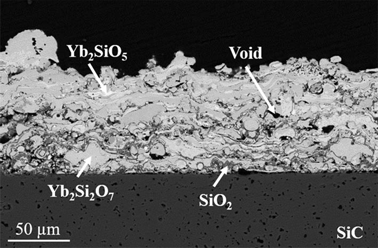Crossref Citations
This article has been cited by the following publications. This list is generated based on data provided by
Crossref.
Perrudin, François
Petitjean, Carine
Panteix, Pierre-Jean
Brix, Florian
Bonnal, Justine
Bonina, David
and
Vilasi, Michel
2022.
Synthesis and Structural Refinement of Isomorphic Cyclosilicate Ca3re2(Si3o9)2 (Re = Nd, Sm, Gd, Dy, Yb).
SSRN Electronic Journal ,
Poerschke, David L.
2022.
Developments in Thermodynamic Models of Deposit-Induced Corrosion of High-Temperature Coatings.
JOM,
Vol. 74,
Issue. 1,
p.
260.
Sun, Luchao
Ren, Xiaomin
Luo, Yixiu
Lv, Xirui
Wang, Jiemin
Oh, Yoonsuk
and
Wang, Jingyang
2022.
Exploration of the mechanism of enhanced CMAS corrosion resistance at 1500 °C for multicomponent (Er0.25Tm0.25Yb0.25Lu0.25)2Si2O7 disilicate.
Corrosion Science,
Vol. 203,
Issue. ,
p.
110343.
Perrudin, François
Petitjean, Carine
Panteix, Pierre-Jean
Brix, Florian
Bonnal, Justine
Bonina, David
and
Vilasi, Michel
2022.
Synthesis and structural refinement of isomorphic cyclosilicate Ca3RE2(Si3O9)2 (RE = Nd, Sm, Gd, Dy, Yb).
Journal of Solid State Chemistry,
Vol. 313,
Issue. ,
p.
123312.
Stokes, Jamesa L.
Bansal, Narottam P.
and
Wiesner, Valerie L.
2022.
Thermochemical degradation of HfSiO4 by molten CMAS.
Ceramics International,
Vol. 48,
Issue. 12,
p.
16499.
Xiao, Shikang
Li, Jianzhang
Huang, Panxin
Zhang, Antong
Tian, Yuhang
Zhang, Xu
Zhang, Jingde
Ryu, Jungho
and
Han, Guifang
2023.
Evaluation of environmental barrier coatings: A review.
International Journal of Applied Ceramic Technology,
Vol. 20,
Issue. 4,
p.
2055.
Bansal, Narottam P.
Costa, Gustavo
Jennings, Wayne D.
and
Garg, Anita
2023.
Interactions between Ca2Gd8(SiO4)6O2 apatite and calcium-magnesium-aluminosilicate (CMAS) at elevated temperatures.
Ceramics International,
Vol. 49,
Issue. 18,
p.
29948.
Stokes, Jamesa L.
Presby, Michael J.
Hoffman, Leland C.
Setlock, John A.
Salem, Jonathan A.
and
Harder, Bryan J.
2024.
Effects of molten silicate reactivity on high temperature erosion behavior of plasma sprayed Yb2Si2O7-based EBCs.
Surface and Coatings Technology,
Vol. 494,
Issue. ,
p.
131078.
Bansal, Narottam P.
Garg, Anita
Jennings, Wayne D.
and
Costa, Gustavo
2024.
Thermochemical interactions between Ca2Sm8(SiO4)6O2 apatite and molten calcium–magnesium-aluminosilicate (CMAS).
Ceramics International,
Vol. 50,
Issue. 10,
p.
17691.
Harder, Bryan J.
Stokes, Jamesa L.
Kowalski, Benjamin A.
Stuckner, Joshua
and
Setlock, John A.
2024.
Steam oxidation performance of Yb2Si2O7 environmental barrier coatings exposed to CMAS.
Journal of the European Ceramic Society,
Vol. 44,
Issue. 4,
p.
2486.
Yang, Fan
Fan, Yun
Zhao, Juanli
Liu, Yuchen
Chu, Kaili
Li, Yiran
Li, Wenxian
and
Liu, Bin
2024.
Mechanical and thermal properties for corrosion products of lutetium silicates against CMAS.
Journal of the American Ceramic Society,
Vol. 107,
Issue. 8,
p.
5285.
Costa, Gustavo
Presby, Michael J.
Almansour, Amjad S.
Webster, Rebeka I.
and
Lee, Kang N.
2024.
Chemical and mechanical properties of modified Yb2Si2O7 environmental barrier coatings corroded by a silicate melt.
Corrosion Science,
Vol. 238,
Issue. ,
p.
112378.
Bonnal, J.
Petitjean, C.
Panteix, P.J.
Saint-Jean, L.
Bonina, D.
Arnal, S.
and
Vilasi, M.
2025.
Influence of the source of yttrium on the morphology of precipitated phases after interaction with a CaO-Al2O3-SiO2 melt at 1300°C.
Materialia,
Vol. 39,
Issue. ,
p.
102374.
Hu, Xunxun
Chen, Yongguo
Guo, Hongbo
and
Xu, Huibin
2025.
Corrosion behaviors and failure mechanism of plasma sprayed Yb2Si2O7/Si environmental barrier coatings exposed to CMAS+ NaVO3.
Journal of the European Ceramic Society,
Vol. 45,
Issue. 3,
p.
117005.
Zhang, Yongqiu
Zou, Binglin
Wang, Ying
Gu, Zhengwei
and
Zhou, Liang
2025.
Hot corrosion of (Yb0.5Y0.5)2Si2O7 and (Yb0.25Y0.25Er0.25Tm0.25)2Si2O7 by CMAS at 1300 °C and 1500 °C.
Ceramics International,



